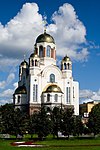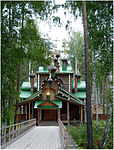Canonization of the Romanovs
Tsar Nicholas II of Russia and Family | |
|---|---|
 Icon of the Romanov Tsar family | |
| Royal Martyrs, Tsar Nicholas II of Russia and Family (ROCOR) Royal Passion-Bearers, Tsar Nicholas II of Russia and Family (Moscow Patriarchate) | |
| Born | 18 May [O.S. 6 May] 1868 (Nicholas II) 6 June [O.S. 25 May] 1872 (Alexandra) 15 November [O.S. 3 November] 1895 (Olga) 10 June [O.S. 29 May] 1897 (Tatiana) 26 June [O.S. 14 June] 1899 (Maria) 18 June [O.S. 5 June] 1901 (Anastasia) 12 August [O.S. 30 July] 1904 (Alexei) Peterhof, Russia; New Palace, Darmstadt, Hesse, German Empire (Tsarina Alexandra) |
| Died | 17 July 1918 Yekaterinburg, Russian Soviet Federative Socialist Republic |
| Venerated in | Russian Orthodox Church Russian Orthodox Church Outside Russia Greek Orthodox Church[1] Serbian Orthodox Church[2] Antiochian Orthodox Church[3] Romanian Orthodox Church Bulgarian Orthodox Church Russian Catholic Church |
| Canonized | 1981 (ROCOR) and 2000 (Moscow Patriarchate), United States and Russia by Russian Orthodox Church Abroad and the Moscow Patriarchate |
| Major shrine | Church on Blood, Yekaterinburg, Russia |
| Feast | 17 July [O.S. 4 July] |
The canonization of the Romanovs (also called "glorification" in the Russian Orthodox Church) was the elevation to sainthood of the last Imperial Family of Russia – Tsar Nicholas II, his wife Tsarina Alexandra, and their five children Olga, Tatiana, Maria, Anastasia, and Alexei – by the Russian Orthodox Church.
The family was killed by the Bolsheviks on 17 July 1918 at the Ipatiev House in Yekaterinburg.[4] The house was later demolished. The Church on Blood was built on this site, and the altar stands over the execution site.[5]
Canonization[edit]
On 1 November 1981, Grand Duke Michael Alexandrovich of Russia (the younger brother of Nicholas II) and his secretary, Nicholas Johnson, were canonized by the Russian Orthodox Church Outside of Russia.[6] The two men were both murdered at Perm on 13 June 1918.[7][8]
On 15 August 2000, the Russian Orthodox Church announced the canonization of Nicholas II and his immediate family for their "'humbleness, patience and meekness'" during their imprisonment and execution by the Bolsheviks.[9]
On 3 February 2016, the Bishops' Council of the Russian Orthodox Church canonized Nicholas II's personal physician, Eugene Botkin, as a righteous passion bearer.[10]
Controversy[edit]
The canonizations were controversial for both branches of the Russian Orthodox Church. In 1981, opponents noted Nicholas II's perceived weaknesses as a ruler and said that his actions had led to the Bolshevik Revolution, which caused so much damage for Russia and its people. One priest of the Russian Orthodox Church Abroad noted that martyrdom in the Russian Orthodox Church has nothing to do with the martyr's personal actions but was instead related to why he or she was killed.[11] Other critics noted that the Russian Orthodox Church Abroad appeared to be blaming Jewish revolutionaries for the deaths and equating the political assassination with a ritual murder.[12]
Others rejected the family's being classified as new martyrs because they were not killed because of their religious faith. There was no proof that the execution was a ritual murder. Religious leaders in both churches also had objections to canonizing the Tsar's family because they perceived him to have been a weak emperor whose incompetence led to the revolution, and the suffering of his people. They said he was at least partially responsible for his own murder and the murders of his wife and children. For these opponents, the fact that the Tsar was said to be, in private life, a kind man and a good husband and father did not override his poor governance of Russia.[11]
Despite their official designation as "passion-bearers" by the August 2000 Council, the family are referred to as "martyrs" in Church publications, icons, and in popular veneration by the people.[13][14]
Since the late 20th century, believers have attributed healing from illnesses or conversion to the Orthodox Church to their prayers to Maria and Alexei, as well as to the rest of the family.[15][16]
Gallery[edit]
-
Yekaterinburg's "Church on the Blood," built on the spot where Nicholas II and his family were murdered in 1918
-
Church of St. Nicholas at the Romanov Monastery near the site where the Romanovs' remains were found at Ganina Yama
See also[edit]
References[edit]
- ^ "Holy Royal Martyrs of Russia". Greek Orthodox Archdiocese of America. Retrieved 6 June 2021.
- ^ "Church in Montenegro Marks Centenary of Romanovs' Deaths". 24 May 2018.
- ^ "St. Alexandra, Passion-Bearer". Antiochian Orthodox Christian Archdiocese of North America. Retrieved 6 June 2021.
- ^ "On This Day in 1918 the Romanov Family Was Killed". The Moscow Times. 2019-07-17. Retrieved 2023-06-15.
- ^ "Church marks killing of Russian tsar". 2003-07-16. Retrieved 2023-06-15.
- ^ "The Russian Orthodox Church Outside of Russia - Official Website". www.synod.com. Retrieved 2023-06-15.
- ^ Yegorov, Oleg (2018-08-01). "Who among the Romanovs survived the Red Terror a century ago?". Russia Beyond. Retrieved 2023-06-15.
- ^ Bychkova, Xenia (2019-08-01). "Tsar Nicholas II And Thailand". The Postil Magazine. Retrieved 2023-06-15.
- ^ "Nicholas II And Family Canonized For 'Passion'". The New York Times. 2000-08-15. ISSN 0362-4331. Retrieved 2023-06-15.
- ^ "Определение Освященного Архиерейского Собора Русской Православной Церкви об общецерковном прославлении ряда местночтимых святых / Официальные документы / Патриархия.ru". Патриархия.ru (in Russian). Retrieved 2023-06-15.
- ^ a b Massie, Robert K., The Romanovs: The Final Chapter, Random House, ISBN 0-394-58048-6, 1995, pp. 134-135
- ^ King, Greg, and Wilson, Penny, The Fate of the Romanovs, John Wiley and Sons, Inc., p. 495
- ^ "Patriarch Aleksy Visited the Place Where the Remains of the Royal Martyrs Had Been Burned" Archived 2005-08-25 at the Wayback Machine, Yekaterinburg, September 23, 2000, Pravoslavie.ru
- ^ GROUNDS FOR CANONIZATION OF THE TSAR FAMILY Archived 2009-05-26 at the Wayback Machine EXCERPTS FROM THE REPORT OF METROPOLITAN OF KRUTITSA AND KOLOMNA JUVENALY (Posted originally on the official web site of the Moscow Patriarchate)
- ^ Serfes, Demetrios (2000). "Miracle of the Child Martyr Grand Duchess Maria". The Royal Martyrs of Russia. Archived from the original on February 13, 2006. Retrieved February 25, 2007.
- ^ Serfes, Demetrios (2000). "A Miracle Through the Prayers of Tsar Nicholas II and Tsarevich Alexis". The Royal Martyrs of Russia. Archived from the original on February 6, 2007. Retrieved February 25, 2007.
External links[edit]
- In Memory of the Royal Martyrs, by St. John of Shanghai and San Francisco
- The Royal Martyrs of Russia (Fr. Netarios Serfes) Archived 2007-02-05 at the Wayback Machine
- New Martyrs, Confessors, and Passion-Bearers of Russia
- Video of the canonization of 1 November 1981 by the Russian Church Abroad
- Video of the canonization of 20 August 2000 by the Moscow Patriarchate


